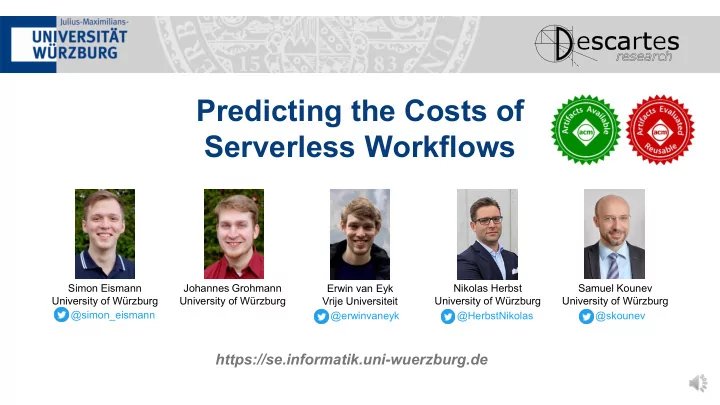

Predicting the Costs of Serverless Workflows Simon Eismann Johannes Grohmann Erwin van Eyk Nikolas Herbst Samuel Kounev University of Würzburg University of Würzburg Vrije Universiteit University of Würzburg University of Würzburg @simon_eismann @erwinvaneyk @HerbstNikolas @skounev https://se.informatik.uni-wuerzburg.de
What are serverless functions? 1. Upload code 2. Setup triggers to run 3. Code is executed 4. Pay for used time with code in response to on-demand with sub-second metering events continuous scaling Predicting the Costs of Serverless Workflows 2 @simon_eismann
Pay-per-use makes estimating costs challenging Cost of serverless functions depends on [1, 2]: • Response time rounded to nearest 100ms • Function size (allocated memory/CPU) • Static overhead per execution Moreover, function response time depends on input [3] Cloud • Function execution in a different context changes cost Expected costs? • Makes estimation of costs for workflows challenging Workflow Existing approaches for cost estimation [4, 5, 6]: • Describe the response time as a static mean • Require user to estimate response time Developer Predicting the Costs of Serverless Workflows 3 @simon_eismann
Summary Problem • Estimating the expected costs of serverless workflows is challenging • Input influences function response time Idea • Build predictive model for workflow costs from production monitoring Benefit • Guides decision between serverless and traditional hosting • Enables comparison of workflow alternatives • First step towards fully automated workflow optimization Predicting the Costs of Serverless Workflows 4 @simon_eismann
Overview Predicting the Costs of Serverless Workflows 5 @simon_eismann
Response Time Mean vs Distribution Mean: 180 ms Naïve: 200 ms Actual: 230 ms Accurate cost prediction requires predicting the response time distribution of a function, not just its mean response time Predicting the Costs of Serverless Workflows 6 @simon_eismann
Predicting the Function Response Time Distribution Gaussian mixture models model distribution as linear combination of gaussian kernels [7] Gaussian mixture models can approximate any distribution assuming sufficient kernels Mixture density networks use DNN to parameterize mixture distribution [8] Predicting the Costs of Serverless Workflows 7 @simon_eismann
Approach 1. Model Workflow Structure 3. Identify next node 5. Repeat steps 3+4 2. Integrate MDNs 4. Monte-Carlo simulation 6. Calculate costs Function 1 Function 2 Function 3 Input MDN1 MDN3 Parameter Parameter parameter MDN5 MDN4 MDN2 $ $ $ Response time Response time Response time Predicting the Costs of Serverless Workflows 8 @simon_eismann
Evaluation RQ1 Can we accurately predict the distribution of the response time and the output parameters of a serverless function? RQ2 Can we accurately predict the costs of a previously unobserved workflow? RQ3 What is the required time for model training and workflow cost prediction? Predicting the Costs of Serverless Workflows 9 @simon_eismann
Case Study Five functions: Two Workflow alternatives: Text to speech Audio format conversion Profanity detection Censor audio segments Compress audio file Predicting the Costs of Serverless Workflows 10 @simon_eismann
RQ 1 – Visual Inspection Can we accurately predict the distribution of the response time and the output parameters of a serverless function? Predicting the Costs of Serverless Workflows 11 @simon_eismann
RQ 1 – Numerical Results Can we accurately predict the distribution of the response time and the output parameters of a serverless function? Normalized, relative Wasserstein metric [9, 10] We can accurately predict the response time and output parameter distributions of serverless functions Predicting the Costs of Serverless Workflows 12 @simon_eismann
RQ 2 - Results Can we accurately predict the costs of a previously unobserved workflow? The proposed approach can accurately predict the execution cost of previously unobserved workflow Predicting the Costs of Serverless Workflows 13 @simon_eismann
RQ 3 - Results What is the required time for training and workflow prediction? Is the overhead feasible for a production environment? Training time for all models with Prediction time hyper-parameter optimization Workflow Prediction time Workflow A 16.34s ± 0.30s Workflow B 14.20s ± 0.03s We consider the time requirements of using our approach in production feasible Predicting the Costs of Serverless Workflows 14 @simon_eismann
Replication package Performance measurements Data set and analysis Wrapped in docker container for Measurement data of serverless platform independent execution functions in public cloud Requires only google cloud Scripts to reproduce any analysis, access keys as input table or figure from the manuscript 1-click reproduction of the results Fully automated performance as a CodeOcean Capsule measurements Available online at: Available online at: https://doi.org/10.5281/zenodo.3582707 https://doi.org/10.5281/zenodo.3582707 Predicting the Costs of Serverless Workflows 15 @simon_eismann
Summary Predicting the Costs of Serverless Workflows 16 @simon_eismann
References [1] Gojko Adzic and Robert Chatley. 2017. Serverless [6] Jashwant Raj Gunasekaran et al.. 2019. Spock: Exploiting computing: economic and architectural impact . In serverless functions for slo and cost aware resource Proceedings of the 2017 11th Joint Meeting on Foundations of procurement in public cloud. In 2019 IEEE 12th International Software Engineering. ACM, 884–889. Conference on Cloud Computing (CLOUD). IEEE, 199–208. [2] Jose Luis Vazquez-Poletti et al.. 2018. Serverless [7] DN Geary. 1989. Mixture Models: Inference and computing: from planet mars to the cloud . Computing in Applications to Clustering . Vol. 152. Royal Statistical Society. Science & Engineering 20, 6 (2018), 73–79. 126–127 pages. [3] Adam Eivy. 2017. Be wary of the economics of [8] Christopher M Bishop. 1994. Mixture density networks . "Serverless" Cloud Computing . IEEE Cloud Computing 4, 2 Technical Report. (2017), 6–12. [9] Luigi Ambrosio et al.. 2008. Gradient flows: in metric [4] Edwin F Boza et al.. 2017. Reserved, on demand or spaces and in the space of probability measures . Springer serverless: Model-based simulations for cloud budget Science & Business Media. planning . In 2017 IEEE Second Ecuador Technical Chapters Meeting (ETCM). IEEE, 1–6. [10] Szymon Majewski et al.. 2018. The Wasserstein Distance as a Dissimilarity Measure for Mass Spectra with [5] Tarek Elgamal. 2018. Costless: Optimizing cost of Application to Spectral Deconvolution . In 18th International serverless computing through function fusion and Workshop on Algorithms in Bioinformatics, 1–21 placement . In 2018 IEEE/ACM Symposium on Edge Computing (SEC). IEEE, 300–312. Predicting the Costs of Serverless Workflows 17 @simon_eismann
Recommend
More recommend